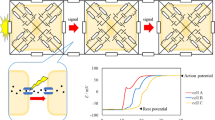Summary
Different sites of theParamecium surface were mechanically stimulated with a fine-tipped glass stylus. Ciliated and deciliated specimens showed a decrease in depolarizing mechanosensitivity and a subsequent increase in hyperpolarizing mechanosensitivity, when the site of stimulation was shifted from the anterior to the posterior end of the cell. Maximal depolarizing sensitivity was observed slightly posterior to the front end of the cell. Specimens without cilia failed to produce action potentials, but no differences in mechanosensitivity were detected. Stimuli given to dorsal surfaces produced larger hyperpolarizations, or smaller depolarizations, than stimuli applied to ventral surfaces at the same latitude. In voltage-clamped cells posterior stimulation elicited outward receptor currents with 5 ms half-time of decay. Inward receptor currents following anterior stimulation decayed with half-times between 20 and 70 ms. Reversal potentials of the receptor currents became more positive, when more anterior surfaces were stimulated. Measurements of the reversal potentials in solutions with varied K and Ca concentrations showed that the posterior receptor currents are exclusively carried by K, while the anterior receptor currents are the sum of K and Ca currents. Ca and K mechanoreceptor currents cancel out in the midposterior region of the cell. Quantitative evaluations of the data suggest that the receptor potentials inParamecium occur due to activated Ca and K mechanoreceptor channels distributing over the somatic cell surface in the manner of overlapping gradients.
Similar content being viewed by others
References
Brehm, P., Dunlap, K., Eckert, R.: Ca-dependent repolarization inParamecium. J. Physiol.274, 639–654 (1978)
Dunlap, K.: Localization of calcium channels inParamecium caudatum. J. Physiol.271, 119–133 (1977)
Eckert, R., Naitoh, Y., Friedman, K.: Sensory mechanisms inParamecium. I. Two components of the electric response to mechanical stimulation of the anterior surface. J. Exp. Biol.56, 683–694 (1972)
Eckert, R., Naitoh, Y., Machemer, H.: Calcium in the bioelectric and motor functions ofParamecium. Symp. Soc. Exp. Biol.30, 233–255 (1976)
Hansma, H.: Biochemical studies on the behavioral mutants ofParamecium aurelia: Ion fluxes and ciliary membrane proteins. Ph. D. Thesis, University of California at Santa Barbara, 1–58 (1974)
Machemer, H., Ogura, A.: Ionic conductances of membranes in ciliated and deciliatedParamecium. J. Physiol. (London) (in press) (1979)
Naitoh, Y., Eckert, R.: Electrophysiology of the ciliate protozoa. In: Experiments in physiology and biochemistry, Vol. 5. Kerkut, G.A. (ed.), pp. 17–38. New York: Academic Press 1972
Naitoh, Y., Eckert, R.: Sensory mechanisms inParamecium. II. Ionic basis of the hyperpolarizing mechanoreceptor potential. J. Exp. Biol.59, 53–65 (1973)
Oertel, D., Schein, S.J., Kung, C.: A potassium channel activated by hyperpolarization inParamecium. J. Membr. Biol.43, 169–185 (1978)
Ogura, A., Takahashi, K.: Artificial deciliation causes loss of calcium-dependent responses inParamecium. Nature London264, 170–172 (1976)
Peyer, J. de, Deitmer, J.W.: Ion-selectivity of voltage- and mechano-sensitive membrane channels inStylonychia. Ann. Meeting Dt. Ges. Biophys., Abstr. B66. Berlin, Heidelberg, New York: Springer 1979
Peyer, J. de, Machemer, H.: Hyperpolarizing and depolarizing mechanoreceptor potentials inStylonychia. J. Comp. Physiol.127, 255–266 (1978a)
Peyer, J. de, Machemer, H.: Are receptor-activated ciliary motor responses mediated through voltage or current? Nature London276, 285–287 (1978b)
Satow, Y.: Internal calcium concentration and potassium permeability inParamecium. J. Neurobiol.9, 81–91 (1978)
Takahashi, M., Naitoh, Y.: Behavioral mutants ofParamecium caudatum with defective membrane electrogenesis. Nature London271, 656–659 (1978)
Author information
Authors and Affiliations
Additional information
Dedicated to Professor B. Rensch on the occasion of his eightieth birthday
The experiments were done by A.O. during his research visit to the laboratory of H.M. We are grateful to our collegue Dr. de Peyer who suggested to carry out the experiments with reversal potentials. We would like to thank Drs. de Peyer and Deitmer for critically reading the manuscript. This work was supported by the Deutsche Forschungsgemeinschaft, SFB 114, TP A5.
Rights and permissions
About this article
Cite this article
Ogura, A., Machemer, H. Distribution of mechanoreceptor channels in theParamecium surface membrane. J. Comp. Physiol. 135, 233–242 (1980). https://doi.org/10.1007/BF00657251
Accepted:
Issue Date:
DOI: https://doi.org/10.1007/BF00657251




